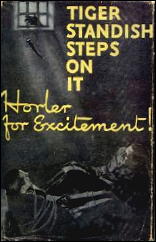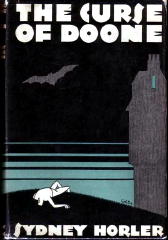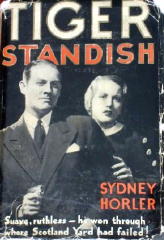Thu 23 Jul 2009
A 1001 MIDNIGHTS review: SYDNEY HORLER – The Curse of Doone.
Posted by Steve under 1001 Midnights , Reviews[9] Comments
by Bill Pronzini:
SYDNEY HORLER – The Curse of Doone. Hodder & Stoughton, UK. hardcover, 1928. Mystery League, US, hardcover, 1930. US paperback reprint: Paperback Library 53-931, 1966.
A journalist and writer of football stories (the British variety) until his early thirties, Sydney Horler began publishing “shockers” in 1925 and went on to produce upwards of a hundred over the next thirty years.

He created a menage of series characters, most of them Secret Service agents of one kind or another, including Bunny Chipstead; “The Ace”; Nighthawk; Sir Brian Fordinghame; and that animal among men, Tiger Standish.
The Standish books — Tiger Standish Steps on It (1940) is a representative title in more ways than one — were especially popular with Horler’ s readership. His greatest literary attribute was his imagination, which may be described as weedily fertile.
His favorite antagonists were fanatic Germans and Fu Manchu-type megalomaniacs, many of whom were given sobriquets such as “the Disguiser,” “the Colossus,” “the Mutilator,” “the Master of Venom,” and “the Voice of Ice”; but he also contrived a number of other evildoers to match wits with his heroes — an impressive list of them that includes mad scientists, American gangsters, vampires, giant apes, ape-men from Borneo, venal dwarfs, slavering “Things,” a man born with the head of a wolf (no kidding; see Horror’s Head, 1934), and — perhaps his crowning achievement — a bloodsucking, man-eating bush (“The Red-Haired Death,” a novelette in The Destroyer, and The Red-Haired Death, 1938).

The Curse of Doone is typical Horler, which is to say it is inspired nonsense. In London, Secret Service Agent Ian Heath meets a virgin in distress named Cicely Garrett and promptly falls in love with her. A friend of Heath’s, Jerry (who worries about “the primrose path to perdition”), urges him to toddle off to his cottage in Dartmoor for a much needed rest.
Which Heath does, though not before barely surviving a mysterious poison-gas attack. And lo! — once there, he runs into Cicely, who is living at secluded and sinister Doone Hall.
He also runs into a couple of incredible coincidences (another Horler stock-in-trade); monstrous vampire bats and the “Vampire of Doone Hall”; two bloody murders; hidden caves, secret panels and caches; a Prussian villain who became a homicidal maniac because he couldn’t cope with his sudden baldness; and a newly invented “war machine” that can force enemy aircraft out of the air by means of wireless waves and stop a car from five miles away.
All of this is told in Hoder’s bombastic, idiosyncratic, and sometimes priggish style. (Horler had very definite opinions on just about everything, and was not above expressing them in his fiction, as well as in a number of nonfiction works. He once said of women: “Of how many women can it truly be said that they are worthy of their underclothes?” And of detective fiction: “I know I haven’t the brains to write a proper detective novel, but there is no class of literature for which I feel a deeper personal loathing.” Racism was another of his shortcomings; he didn’t like anybody except the English.)

This and Horler’s other novels are high camp by today’s standards; The Curse of Doone is just one of several that can be considered, for their hilarious prose, pomposity, and absurd plots, as classics of their type.
Unfortunately, most of Horler’s “shockers” were not reprinted in this country. Of those that were, the ones that rank with The Curse of Doone are The Order of the Octopus (1926), Peril (1930), Tiger Standish (1932), Lord of Terror (1937), and Dark Danger (1945).
———
Reprinted with permission from 1001 Midnights, edited by Bill Pronzini & Marcia Muller and published by The Battered Silicon Dispatch Box, 2007. Copyright © 1986, 2007 by the Pronzini-Muller Family Trust.
July 23rd, 2009 at 2:18 pm
Weedy is perhaps the perfect word to describe Horler’s imagination, a mix of the weird, the odd, the melodramatic, and not a small bit of sheer gothic nonsense that might have come out of Monk Lewis playbook.
And as Bill says in the review Horler was simply an awful human being. He seems to have hated just about everyone of every race save the English and only approved of a small proportion of them. His vitriolic letters to the editor were famous in his day, and at least once he started a riot at Wimbledon over a woman player wearing shorts.
He was a great admirer of Edgar Wallace and even bought Wallace’s desk when the master died in an attempt to tie himself to his idol. He had a famous feud with Dorothy L. Sayers after she dared give a bad review of one of his books and bordered on slander with his comments of writer Michael Arlen. He once took writer Gilbert Frankau to task for calling his hero ‘Marcus Orlando.’
Yet he is one of the great alternative writers, and can be almost compulsively readable in his sheer badness. Still he doesn’t rise to the level of one of the ‘great bad writers’ since unlike most of them, there is nothing universal or unique to his work. He stumbles on no deeper themes like Edgar Rice Burroughs adventure as wish fulfillment or Sax Rohmer’s magnificent Fu Manchu.
There is little that is original in Horler. Tiger Standish is a pale imitation of Bulldog Drummond, and his super villain Paul Vivanti Guy Boothby’s is Dr. Nikola crossed with Professor Moriarty, but lacking either characters magnificence. His novel The Vampire is a good example of his work, managing to condense Bram Stoker’s Dracula into some 50,000 words without once approaching the original’s genius.
His gentleman crook The Nighthawk does manage one twist that would shock the Saint, the Baron, Raffles, Blackshirt, or Arsene Lupin. The Nighthawk preys on women of what he considers low character, stealing their jewels and scribbling rude comments about them on their dressing table mirror in lipstick — to add insult to injury using their own lipstick. It’s a wonder the Saint didn’t have him blackballed from the Gentleman Crooks Club.
To the famous tag ‘Horler for excitement,’ it perhaps should also have been added Horler for jingoism, melodrama, bizarre imagination, and ill will.
Still, he can be fun to read so long as you know what you are getting going in. There is a some pleasure to be derived from those passages where you stop and go “ohmigod I can’t believe he wrote that!”
July 23rd, 2009 at 5:16 pm
No doubt like most people these days, I hadn’t heard of Mr. Horler until I’d read Pronzini’s wonderful GUN IN CHEEK books.
Horler’s craziness is kind of enjoyable, or at least weirdly entertaining.
July 23rd, 2009 at 7:12 pm
I’ve never read anything by Horler myself, but now I’m certainly tempted!
July 23rd, 2009 at 8:25 pm
I find Horler genuinely unpleasant to read. Both in his fiction and nonfiction he seemed motivated so much by resentment of others. Edgar Wallace seemed a much more genial person both in his life and his works.
July 23rd, 2009 at 8:38 pm
I think I will start with only one of his books, then, just as a precaution. No need to wait until I have all 100 that he wrote, plus or minus, before giving him a go!
July 23rd, 2009 at 10:12 pm
Steve
If you are reading Horler one of the best places to start would be this one, The Curse of Doone, which is one of his best (a relative term in Horler’s case). The Vampire is fairly good and not too hard to find since it was reprinted by Bookfinger. Secret Service Man, any of the Tiger Standish books, or Chipstead of the Lone Hand are fairly good places to begin too.
Here’s a little character study from The Black Heart in which Napoleon Miles (Nap) battles treason and Reds allied with Huns (oh my);
Siegmund von Scheidemann, lounging near his superior with a contemptuous grin upon his ruddy face, made a worth-while study. He was a curious mixture of the aristocrat (as they know the breed in Germany) and the complete cad. He affected a tremendous scorn of anyone not born in the purple and yet he stooped daily to acts which would have shamed a common thief or lowest criminal.
AND for Horler that’s pretty mild stuff. Virus X, a Paul Vivanti story isn’t bad (for Horler) and the above mentioned Horror Head, is, pardon the pun, a howl. That said, Tiger Standish Steps On It could probably have been equally well named Tiger Standish Steps In It.
But Horler can be wildly bad and that makes him readable in a slightly masochistic way that only truly bad writers can be. He’s no Harry Stephen Keeler, but in his own breathless way he carved his own niche in the insanely bad stakes. He could almost define one type of alternative classic.
Curt
I won’t disagree, Horler is genuinely unpleasant, but it is so exaggerated and over the top at some point he becomes a sort of literary Archie Bunker (or Steptoe the original Brit Archie). A prig, racist, sexist, and probably many other unpleasant …ists Horler is such an awful person that reading him becomes fun. And even in his day when he was a major seller in England he was considered by his readers to be a bit odd. I’m not sure anyone but booksellers ever took him seriously.
And yes, Edgar Wallace is a far nicer man. Even Wallace Sanders’ stories are at worst a bit paternalistic despite their imperialist African settings and the racism implicit in such stories in that era. As I said in my Sapper review even H.C. McNeile seems a paragon of reason and good will compared to Horler, M.P. Shiel, and William Hope Hogdson. The Brits after all earned their reputation for eccentrics.
July 23rd, 2009 at 11:05 pm
Have you read the Pym books by Nigel Morland? Some of the early ones are so over the top it had to reflect deliberate parody by the author, surely. Horler I think was dead serious.
I like Edgar and am sorry when he gets lumped in with the more bigoted thriller writers. I think he was much more interesting than he often gets credit for being these days.
July 26th, 2009 at 12:54 am
Miss Pym was in many ways the female version of Wallace’s Mr. J.G. Reeder, and as you say. surely Morland was having fun with the reader. I’ve never seen any evidence Horler was even possessed with a sense of humor, much less that the wrote humorously.
And yet he is bad in a way that can be compulsively readable, and while he seems to have been an awful person — and it shows in his books — he’s seldom dull despite the fact that he is possessed of an imagination better suited to penny dreadfuls than thrillers. It’s worth reading one or two just to see for yourself, and they can be perversely entertaining as only true alternative classics are. And you ought to read at least one book by a man who named one of his heroes Bunny Chipstead.
And yes, Wallace should never be lumped with the racist lot that wrote at the same time as him. He was a man of his time, but there is little of the nonsense in his books that mar other writers of the age. That said, sinister orientals and the like do show up in his books, but never with any real venom or conviction behind them other than as standard villains.
I can’t imagine him creating a character like Sax Rohmer’s anti-Semitic Severac Babylon, a Jewish Robin Hood who preyed on Jewish moneylenders and the like who defrauded Christians. And even in the Sanders stories the natives have a certain nobility with the bad ones balanced by the good ones however distasteful Sanders paternalistic behavior may be.
Certainly when you suggest someone try Wallace you seldom feel you have to justify the choice by saying something about his racial attitudes as you do some other writers of the era.
May 23rd, 2010 at 10:10 pm
I have read only two of Horler’s novels, and while the plotting was weak, they had a fairly good amount of action, and he knew how to keep a story moving along. I think the big appeal of writers such as Horler and H.C. McNeil was that their heroes were men of action, who were quite prepared to kill the evildoers, without remorse–James Bond forerunners. I didn’t note misogyny etc. in the two Horlers I read, and some Americans help the heroes.